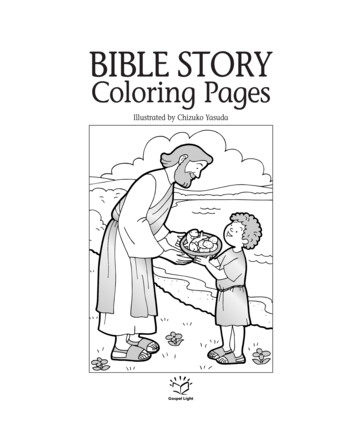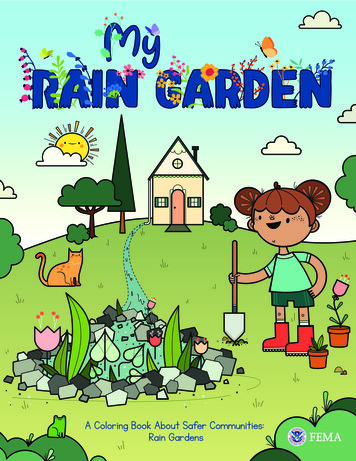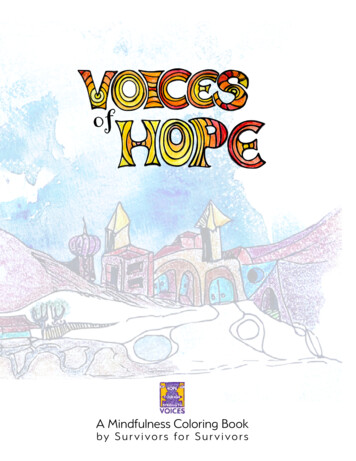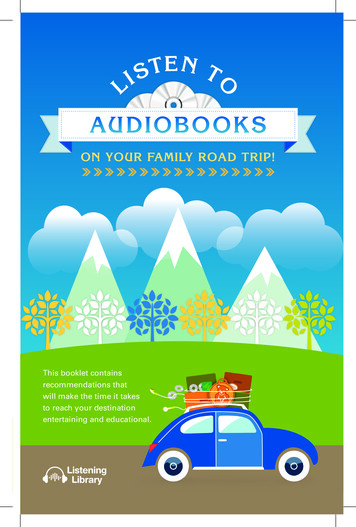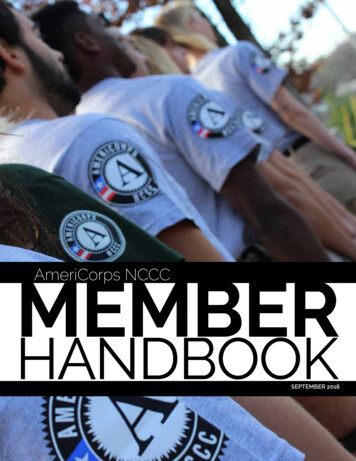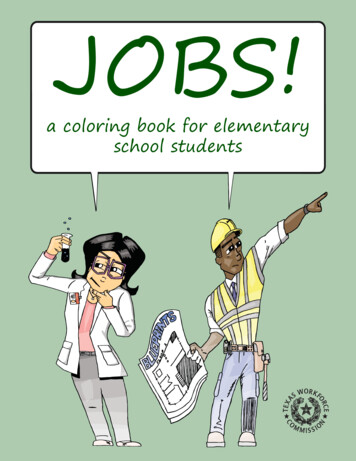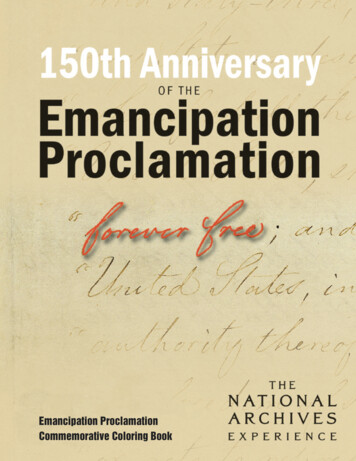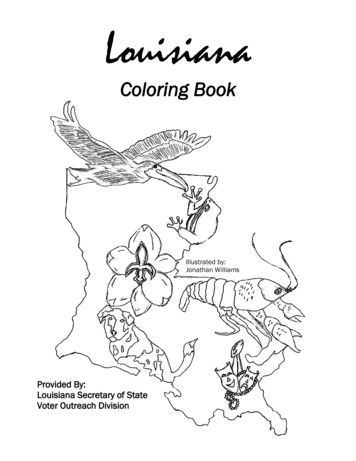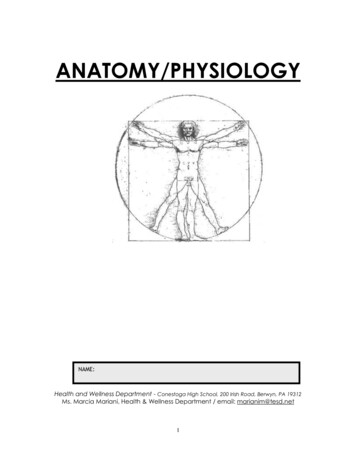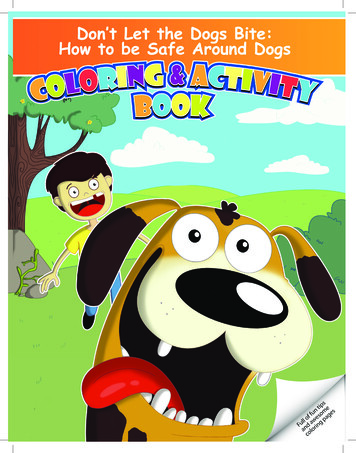
Transcription
%JTBTUFS 1SFQBSFEOFTTColoring Book'&."m & OctoCFS 1993!MERICAN2ED #ROSS
Fire. Hurricane. Flood. Thunderstorm.Dear Parent or Educator,News stories of disaster regularly make headlines around the globe.As you’ve watched others deal with these emergencies, you mayhave wondered what would happen if a disaster struck closer to home.For parents or teachers of young children, the thought is even more troubling. How would you and your children cope? Perhaps you’ve alreadyexperienced a disaster — what would you do differently next time? Theanswer to both questions is clear. Be prepared.This coloring book is designed for adults and children to work on together.Children can learn about fire, earthquakes, floods, tornados and otherdisasters, as well as how to protect themselves — all while having funcoloring.Work through each section with children to make sure they understandthe concepts and learn important safety messages. To help you do this,each coloring page is accompanied by key points to talk about andaction steps to take. You may want to review this information beforemeeting with children. The coloring book ends with a “quiz” that can helpyou find out if they learned the information. From time to time, quiz children again and practice key steps to help them remember what to do.Children are wonderful at adapting to situations when they know what toexpect. By creating a family disaster plan, you can help children beready to deal with emergencies. For more information, ask for materialsabout specific disasters and for a copy of Your Family Disaster Plan fromyour local office of emergency management (publication #L-191) orAmerican Red Cross chapter (publication #ARC4466). Or write to FEMA,P.O. Box 70274, Washington, DC 20024, and ask for Publication #L-191.
Tornado. Earthquake. Winter Storm.Hey Kids!Wind makes kites fly. Fire can keep us warm. And rain helps flowers grow.But sometimes the wind blows too hard, fires get too big or it rains too much.Learn what to do when nature shows off!This book will help you. But you’ll need to ask an adult to work with you. GetMom, Dad, your teacher or an adult friend to read this book while you color.Have fun!
Natural DisastersDisasters can strike quickly and without warning.While a disaster is frightening for adults, it can betraumatic for children if they don’t know what to do.Help children understand the conceptof a disaster. Explain that nature sometimes provides“too much of a good thing” — fire, rain,wind, snow. Tell them that a disaster iswhen something happens that could hurtpeople, cause damage or cut off utilitiessuch as water, telephones or electricity. Give examples of several disasters thatcould happen in your community. To getthis information, contact your local office ofemergency management or local American Red Cross chapter. Ask what disastersare most likely to happen and requestinformation on how to prepare for them. Talk about typical effects that childrencan relate to, such as loss of electricity,water and telephone service. Explain that when people know what todo — and practice in advance — everyone is better able to handle emergencies.That’s why we need to create a familydisaster plan.
Nature is beautiful.and powerful!
EmergenciesEven very young children can be taughthow and when to call for help.Action Steps for Adults Help children recognize the warning signsfor the disasters that could happen in yourcommunity. You can get this informationfrom your local emergency managementoffice or American Red Cross chapter. Tell children thatin a disaster thereare many peoplewho can helpthem. Talkabout ways thatan emergencymanager, RedCross volunteer, police officer, firefighter,teacher, neighbor, doctor or utility workermight help following a disaster. Teach children how and when to call forhelp. Check the telephone directory forlocal emergency telephone numbers. Ifyou live in a 9-1-1 service area, teachchildren to call 9-1-1. At home, post emergency telephone numbers by all phonesand explain when to call each number. Even very young children can be taughthow and when to call for emergency assistance. If a child can’t read, this emergencytelephone number chart has pictures thatmay help him or her identify the correctnumber to call. As you explain each picture, have the child color the symbol on thechart. Take a first aid and CPR course. These arecritical skills, and learning can be a funactivity for older children. Contact yourlocal office of emergency management,American Red Cross chapter or hospital forinformation. At home, ask an out-of-state friend to beyour family “check-in” contact. After adisaster, long-distance telephone lines oftenremain in service even when local lines aredown. Tell children to call this “check-in”contact if they are separated from the familyin an emergency. Help them memorize thetelephone number, or write it down on acard they can keep with them.
EmergencyPhone NumbersMy Family Name:My Phone Number:My Address:My Town:AmbulanceFirePolice/SheriffMotherFatherOther
FireFire is the disaster that families are most likely to experience.Talk with children about fire safety, andpractice these activities with them. Keepin mind that children under age five are athighest risk.Safety Messages for Kids “Matches and lighters are tools, not toys.These tools help adults use fire properly. Ifyou see someone playing with fire, tell anadult right away.” “If a fire starts in your home or you hearthe smoke detector alarm, yell ‘Fire!’ severaltimes and go outside right away. If you livein a building with elevators, use the stairs.Never try to hide from fire. Leave all yourthings where they are. Once you are outside, go to your meeting place and thensend one person for help.” “If your clothes catch fire.stop, drop androll. Stop what you are doing, drop to theground, cover your face and roll over andover until the flames go out. Running willonly make the fire worse.”Action Steps for Adults Show children how to crawl low, under thesmoke to escape. Explain that they shouldfeel a door before opening it. If the door is cool,open it slowly. If the door is hot, find anotherway out. If they cannot get outside safely,instruct them to hang a sheet outside a window so firefighters can find them. Practice “stop, drop and roll” with children.Explain that running away will only makethe fire burn faster.At home: Choose an outside meeting place, such as atree, street corner or mailbox. Make sure it willbe a safe distance from heat, smoke andflames. Tell children to go directly to this meeting place in case of a fire. This plan will helpyou know quickly if everyone got out safely. Make sure that children understand thatonce they are outside, they should stay outside. Children are often concerned about thesafety of their pets, so discuss this issue before afire starts. Find two ways to escape from every roomand practice getting out of your home duringthe day and at night. Chart these escaperoutes on your own “home escape plan.” Ifyou have an escape ladder, show kids whereit’s kept and how to use it. Practice your home escape plan at leasttwice a year. Quiz children every six monthsso they’ll remember what to do and where tomeet. Install smoke detectors on every level ofyour home, especially near bedrooms. Cleanand test them monthly, and change the batteries at least once a year. Make sure childrenknow what your smoke detector sounds like. Check electrical wiring in your home. Fixfrayed extension cords, exposed wires or looseplugs. Make sure your home heating source isclean and in working order. Many home firesare started by faulty furnaces or stoves,cracked or rusted furnace parts and chimneyswith creosote build-up.
If a fire starts, yell “Fire!” and go outside rightaway. Go to your outside meeting place.My Meeting Place
ThunderstormsLightning always accompanies a thunderstorm.And lightning can strike the same place twice!Athunderstorm is a storm with lightningcaused by changes in air pressure.Severe thunderstorms can bring heavyrains (which can cause flash flooding),strong winds, hail and tornados. At anygiven moment, nearly 1,800 thunderstormsare in progress over the face of the earth!And stay away from metal things thatlightning may strike, such as umbrellas,baseball bats, fishing rods, camping equipment and bicycles.”The sound of thunder can be especiallyfrightening for young children. Take the“scariness” away by teaching them what toexpect during a thunderstorm and how tobe safe. “Lightning can cause electric appliances,including televisions and telephones, tobecome dangerous during a thunderstorm.Turn off the air conditioner and television,and stay off the phone until the storm isover.”Safety Messages for Kids “If you see or hear a thunderstorm coming, go inside a sturdy building or car.” “If you can’t get inside.or if you feel yourhair stand on end, which means lightningis about to strike.hurry to a low, openspace immediately. Crouch down andplace your hands on your knees.Move away from tall thingslike trees, towers, fences,telephone lines or powerlines. They attract lightning. Never stand underneath a single large treeout in the open becauselightning will hit the highest point in an area. “If you are boating or swimming, get toland immediately.”Action Steps for Adults Explain what to expect during a thunderstorm. Describe the loud thunder andflashes of lightning. Make sure childrenunderstand that they can stay safe. Talk about the danger signs; dark, towering clouds or distant lightning and thundercan signal an approaching thunderstorm. Practice the “crouch down” position withchildren.
If you see storm clouds or hearthunder, go inside right away.
TornadosTornados are nature’s most violent storms —they can devastate an area in seconds.Atornado appears as a rotating, funnelshaped cloud, striking the groundwith whirling winds of up to 200 miles perhour. A tornado spins like a top and maysound like an airplane or train. Most tornados travel a distance of about 10 miles,although “tornado tracks” of 200 miles havebeen reported. Tornados can happen justabout anywhere in the United States.Safety Messages for Kids “Wherever you are, if you hear or see atornado coming, take cover right away.” “If you’re in a house or apartment building, go to the basement or storm cellar. Ifthere is no basement, go to the middlesection of the building on the lowest level —and go into a bathroom or closet, if possible.” “Get under something sturdy, such as aheavy table, and stay there until the danger has passed. Use your arms and handsto protect your head from falling or flyingobjects.” “If you’re outside,in a car or in amobile home, goimmediately to thebasement of anearby sturdy building.If there is no shelter nearby,lie flat in a low spot. Use your arms andhands to protect your head. If you hear orsee water, move quickly to another spot.”Action Steps for Adults With children, find some safe places inyour home or classroom. Make sure theseplaces are away from windows and heavyfurniture that could tip over. Also, showchildren an example of a safe place outside. Know the terms used on the radio ortelevision that warn of possible approaching tornados:Tornado Watch: Weather conditions areright for tornados to develop. A watchdoes not necessarily mean a tornado willdevelop.Tornado Warning: A tornado has beensighted and is dangerous. This is thetime to go to a safe place and listen toa battery-operated radio for instructions. Find out what warning system is used inyour community. If you live in a single-family home in atornado-prone area, find out how to reinforce an interior room on the lowest level ofyour home (such as the basement, stormcellar, bathroom or closet) to use as a shelter.
If a tornado is coming, go to asafe place right away.
HurricaneA hurricane is a tropical storm with windsreaching 74 miles per hour or more.Hurricane winds blow in a large spiralaround a relatively calm centerknown as the “eye.” The “eye” is generally20 to 30 miles wide, and the storm mayspread outward as far as 400 miles. As ahurricane approaches, the skies will beginto darken and winds will increase. As ahurricane nears land, it can bring heavyrains, strong winds and extremely hightides.Safety Messages for Kids “During a hurricanewatch, we’ll listen regularlyto the radio or television forofficial instructions.” “If officials announce a hurricane warning, they may ask us to leave our home assoon as possible to be safe. We’ll take ourdisaster supplies kits and go to a shelter or to(fill in).We’ll call our “check-in” contactso someone will know where we’re going.”(Note: For information on how to assemblea disaster supplies kit, please refer to the“Disaster Supplies Kit” section.)Action Steps for Adults Know the terms used on the radio ortelevision that warn of potential hurricaneconditions:Hurricane Watch: A hurricane maystrike your area within 24-36 hours.Hurricane Warning: Hurricane conditions are expected in your area within 24hours. Coastal areas may need to beevacuated. Talk about what you would do in anevacuation. Consider where you would goand what you would take. Keep a battery-operated radio in casepower goes out. Measure and cut plywood to cover yourwindows.
If a hurricane is coming, your family may needto leave home and go to a safer place.
FloodsFloods are the most common and widespread of all natural hazards.Even very small streams, gullies, creeks,culverts, dry streambeds or low-lyingground that may appear harmless in dryweather can flood.Safety Messages for Kids ”If you come upon flood waters, stop.Turn around and go another way. Climbto higher ground.””Stay away from flooded areas.even if itseems safe, the water may still be rising.Never try to walk, swim or dive into thewater because it may be moving veryfast.” (NOTE: Less than six inches of fastmoving flood water can knock people offtheir feet, and two feet of water will float acar.) “If you are in a car, get out immediatelyand move to higher ground.” “Watch out for snakes in areas that wereflooded.” “Never play around high water, stormdrains, ditches, ravines or culverts.” “Throw away food that has come intocontact with flood waters.eating it couldmake you very sick.”Action Steps for Adults Know the terms used on the radio ortelevision that warn of potential floodingconditions:Flood/Flash Flood Watch: Flooding orflash flooding may occur within thedesignated WATCH area — be alert.Flood/Flash Flood Warning: Flooding orflash flooding has been reported or isimminent — take necessary precautionsat once. Find out if you live in a flood plain. Ifyou do, call your local emergency management office or American Red Crosschapter to learn what types of suppliesshould be stored to protect your homefrom floodwater. Know the elevation of your property inrelation to nearby streams and dams sothat you will know if forecasted flood levelswill affect your home.
If you see flood waters, move away fromthem. Go to a higher place. Never playnear or try to swim in flood waters.
Winter StormsA winter storm can range from several inches of snow over afew hours to blizzard conditions that last several days.Winter storms can last several daysand be accompanied by high winds,freezing rain or sleet, heavy snowfall andextreme cold. People can becomestranded on the road or trapped at home,without utilities or other services. Most ofthe United States is at some risk from winterstorms.Safety Messages for Kids “The best way to stay safe in a snowstorm is to stay inside.” “If you go outside to play after a snowstorm, dress in many layers and wear ahat and mittens. Come inside often forwarm-up breaks.” “If you start to shiver a lot or get verytired.or if your nose, fingers, toes or earlobes start to feel numb or turn really pale come inside right away and tell an adult.”Action Steps for Adults There are ways to dress children in coldweather that will keep them warmer.Many layers of thin clothing are warmerthan single layers of thick clothing. One ofthe best ways to stay warm is to wear ahat; most body heat is lost through the topof the head. Keep hands and feet warmtoo. Mittens are warmer than gloves.Covering the mouth with a scarf protectslungs from extremely cold air. Teach children how to watch for signs offrostbite and hypothermia. A loss of feelingand a white or pale appearance in fingers,toes, nose or ear lobes are symptoms offrostbite. Uncontrollable shivering, slowspeech, memory lapses, frequent stumbling, drowsiness and exhaustion aresymptoms of hypothermia. If you suspectfrostbite or hypothermia, warm the childand seek immediate medical assistance. Children should also avoid overexertion.Cold weather puts an added strain on theheart. In your home, have available some kindof emergency heating equipment and fuelso you can keep at least one room of yourhome warm. If your furnace is controlledby a thermostat, and the power goes out,you will need emergency heat. If you are trapped in your car during asnowstorm, stay there. Leave the car onlyif help is visible within 100 yards. To attractattention, hang a brightly colored cloth onthe radio antenna and raise the trunk. Turnon the car’s engine for about 10 minutes eachhour. Run the heater and turn on the domelight when the car is running. Keep theexhaust pipe clear of snow and open adownwind window slightly for ventilation.
When there is snow outside, bundle up in lots oflayers of clothing and wear a hat. Ask an adultif it’s okay to play outside — and come insideoften for “warm-up” breaks.
EarthquakesEarthquakes can happen anywhere, anytime.An earthquake is a sudden, fast shakingof the earth. One can strike withoutwarning — causing fires, explosions andlandslides. Earthquakes happen whenrock that is below the earth’s surface breaksand shifts. People in all states are at somerisk from earthquakes.Safety Messages for Kids “If you’re indoors during an earthquake,drop, cover and hold on. Get under adesk, table or bench.hold on to one of thelegs and cover your eyes. If there’s notable or desk nearby, sit down against awall. Pick a safe place where things willnot fall on you, away from windows, bookcases or tall, heavy furniture.” “Wait in your safety spot until the shakingstops, then check to see if you are hurt.Check the people around you too. Movecarefully and watch out for things thathave fallen. Be ready for smaller earthquakes called aftershocks.” “Be on the lookout for fires. Earthquakescan cause fire alarms and fire sprinklers togo off. If you must leave a building afterthe shaking stops, use the stairs, not theelevator.” “If you’re outside in anearthquake.stay outside. Move away frombuildings, trees, streetlights and power lines.Crouch down andcover your head.” “If you are in a car, stay there with yourseatbelt fastened.”Action Steps for Adults Help children understand what to expectin an earthquake and how to protect themselves. With children, find safe places in everyroom of your home or the classroom. Practice “drop, cover and hold on”.gettingunder a table or other sturdy object. Lookfor safe places inside and outside of otherbuildings where you spend time. Explain that it is dangerous to run outsidewhen an earthquake happens becausefalling objects can hurt people. Tell children to be prepared for aftershocks — smaller earthquakes that canhappen over a period of weeks (and sometimes months) after the first earthquake. Besure they know to go to a safe place duringaftershocks. At home, bolt down water heaters andgas appliances. Place large or heavyobjects and fragile items (such as glass orchina) on lower shelves. Securely fastenshelves to walls. Brace or anchor high ortop-heavy objects.
If you’re indoors during an earthquake,drop, cover and hold on.
Disaster Supplies KitAssemble Disaster Supplies Kits with Your Children.ollowing a disaster, basic services —electricity, water, gas, telephones —may be cut off for days. Or, you may haveto evacuate at a moment’s notice. Youprobably won’t have time to shop or searchfor the supplies you’ll need. Gather thesupplies you’ll need to deal with the situation now, before disaster strikes.FAction Steps for AdultsPlan an activity with children to put together disaster supplies kits.At home, your kits should contain: One gallon of water per person per day Non-perishable food: ready-to-eatcanned meats, fruits and vegetables;canned juices, milk and soup; sugar, saltand pepper; high energy foods such aspeanut butter, jelly, crackers, nuts, healthfood bars, trail mix; comfort foods such ascookies, hard candy and sweetened cereal. Don’t forget a non-electric can opener! A first aid kit that includes your family’sprescription medications (ask your doctorabout proper ways to store medicine) Emergency supplies and tools includinga battery-operated radio, flashlight andplenty of extra batteries One change of clothing and footwearper person, and one blanket or sleepingbag per person Sanitation supplies: toilet paper, soap,personal hygiene items Special items for infant, elderly or disabled family members An extra set of car keys and cash,traveler’s checks and a credit cardStore enough supplies to last at least threedays. Keep them in sturdy, easy-to-carrycontainers such as backpacks, duffle bagsor covered trash containers. Store your kitsin a safe, convenient place known to allfamily members — preferably in a cool,dry, dark place. Keep a smaller version ofthis kit in the trunk of your car. You shouldalso keep important family documents in awaterproof container.In the classroom, your kit should contain: class roster first aid kit battery-operated radio work gloves flashlights extra batteries non-perishable food items; crackers,cookies, trail mix plastic trash bags other items as your school requiresAsk children to help you remember to keepyour kits in working order: change thewater and food every six months; replacebatteries at least twice a year. You mighthave them make calendars or posters withthese dates marked on them. And askchildren to think of items that they wouldlike to include in their own disaster supplieskit, such as books or games or appropriatenon-perishable food items.
We can keep supplies that will help us if a disasterhappens. Put together a disaster supplies kit today!
Family Disaster PlanPractice your plan so everyone will remember what to do! Hold emergency escape drills. Test smoke detectors and change the batteries. Keep disaster supplies kits up-to-date.Quiz children every few months to help them remember what to do.Here are some questions you can ask right now to make surethey’ve learned key concepts:1. What will you do if you’re in your room and smell smoke or hear thesmoke detector go off? Where will you go?2. What will you do if you see dark clouds and hear thunder?3. How might you know that a tornado is coming? If a tornado is coming,where will you go? What will you do to protect yourself?4. If we are told that a hurricane is coming, what are some of the things wewill do to get ready?5. Why should you stay away from flood waters?6. What will you do if your clothes catch fire?7. When you play outside in the snow, what will you do to make sure youdon’t get too cold?8. If the earth starts to shake, what will you do?9. Who will you call for help in an emergency? Where can you find thesetelephone numbers?10.What are some things you want to put in your disaster supplies kit?11.What will you do if you see a friend playing with matches?
This coloring book is designed for adults and children to work on together. Children can learn about fire, earthquakes, floods, tornados and other disasters, as well as how to protect themselves — all while having fun coloring. Work through each section with children to make sure they und
